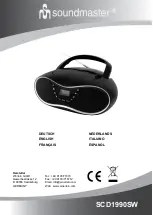
15
TD-000472-00-B
EQ Tab
For the Main and mono Aux outputs, the EQ tab displays the 1/3 octave graphic
equalizer. To better fit the screen, the equalizer has been divided into four sections –
Low, Low-Mid, High-Mid and High. The four windows will display the setting of all faders.
Touch any of the windows to work on that part of the frequency spectrum.
For Auxes 7/8 and 9/10 (TouchMix-16 only) the EQ is parametric and is identical to that
found on input channels.
Limiter Tab
Displays the limiter and its controls. We strongly encourage the use of the limiter for In Ear Monitors.
Filters Tab
There are multiple types of filters presented here.
•
Low-Cut / High-Cut filters
– These filters are used to roll off high or low frequency content. There are a number of possible applications. See
Tips & Tricks for more on Low and High-Cut filters.
◦
For
stage monitors
, it is common to roll off low frequencies at 80 – 100 Hz. There is usually ample low frequency energy on stage without
any help from the monitors. Keeping it out of the monitors can reduce “rumble” on stage and in the house.
◦
For
speech
only systems, rolling off low frequencies can reduce microphone handling noise or, if outdoors wind noise.
◦
Fill speakers
may not need any additional low-frequency energy as there is ample bottom end coming from subwoofers.
◦
There is a technique known as “
subs on auxes
” in which the subwoofer is fed from one of the auxes while the main speakers are fed from
the mixer’s main outputs. Only those instruments that contain low-frequencies are sent to the subwoofer. This provides more control over the
lows and can help keep the bottom end tighter. If this is being done, the Low and High-Cut filters could be used to set the crossover point
between subs and main speakers.
•
Anti-Feedback Notch Filters
– These are very deep (up to -20 dB), very narrow cut only filters that can be quite effective in fighting feedback
frequencies while doing little to alter the overall sound. Experienced engineers will bring the system up just to the edge of feedback while adjusting
the frequency to tune out feedback. This must be done with care as the system is very close to uncontrolled feedback.
Presets Tab
This tab offers a Factory Preset named Reset that returns all output control parameters to their factory values. In addition, any settings you make can
be stored to or recalled from either internal or external (USB) memory.
— Figure 6 —
Low
Low Mid
High Mid
High
31.5 to
125 Hz
160 to
630 Hz
800 Hz to
3.15 kHz
4 to
16 kHz
















































